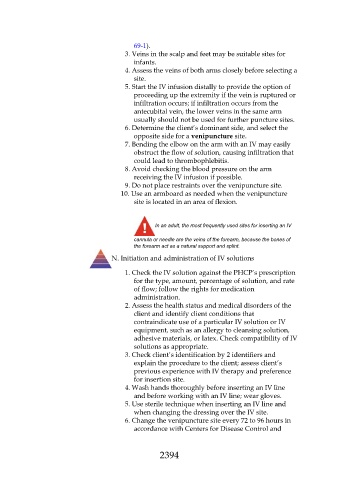Page 2394 - Saunders Comprehensive Review For NCLEX-RN
P. 2394
69-1).
3. Veins in the scalp and feet may be suitable sites for
infants.
4. Assess the veins of both arms closely before selecting a
site.
5. Start the IV infusion distally to provide the option of
proceeding up the extremity if the vein is ruptured or
infiltration occurs; if infiltration occurs from the
antecubital vein, the lower veins in the same arm
usually should not be used for further puncture sites.
6. Determine the client’s dominant side, and select the
opposite side for a venipuncture site.
7. Bending the elbow on the arm with an IV may easily
obstruct the flow of solution, causing infiltration that
could lead to thrombophlebitis.
8. Avoid checking the blood pressure on the arm
receiving the IV infusion if possible.
9. Do not place restraints over the venipuncture site.
10. Use an armboard as needed when the venipuncture
site is located in an area of flexion.
In an adult, the most frequently used sites for inserting an IV
cannula or needle are the veins of the forearm, because the bones of
the forearm act as a natural support and splint.
N. Initiation and administration of IV solutions
1. Check the IV solution against the PHCP’s prescription
for the type, amount, percentage of solution, and rate
of flow; follow the rights for medication
administration.
2. Assess the health status and medical disorders of the
client and identify client conditions that
contraindicate use of a particular IV solution or IV
equipment, such as an allergy to cleansing solution,
adhesive materials, or latex. Check compatibility of IV
solutions as appropriate.
3. Check client’s identification by 2 identifiers and
explain the procedure to the client; assess client’s
previous experience with IV therapy and preference
for insertion site.
4. Wash hands thoroughly before inserting an IV line
and before working with an IV line; wear gloves.
5. Use sterile technique when inserting an IV line and
when changing the dressing over the IV site.
6. Change the venipuncture site every 72 to 96 hours in
accordance with Centers for Disease Control and
2394

